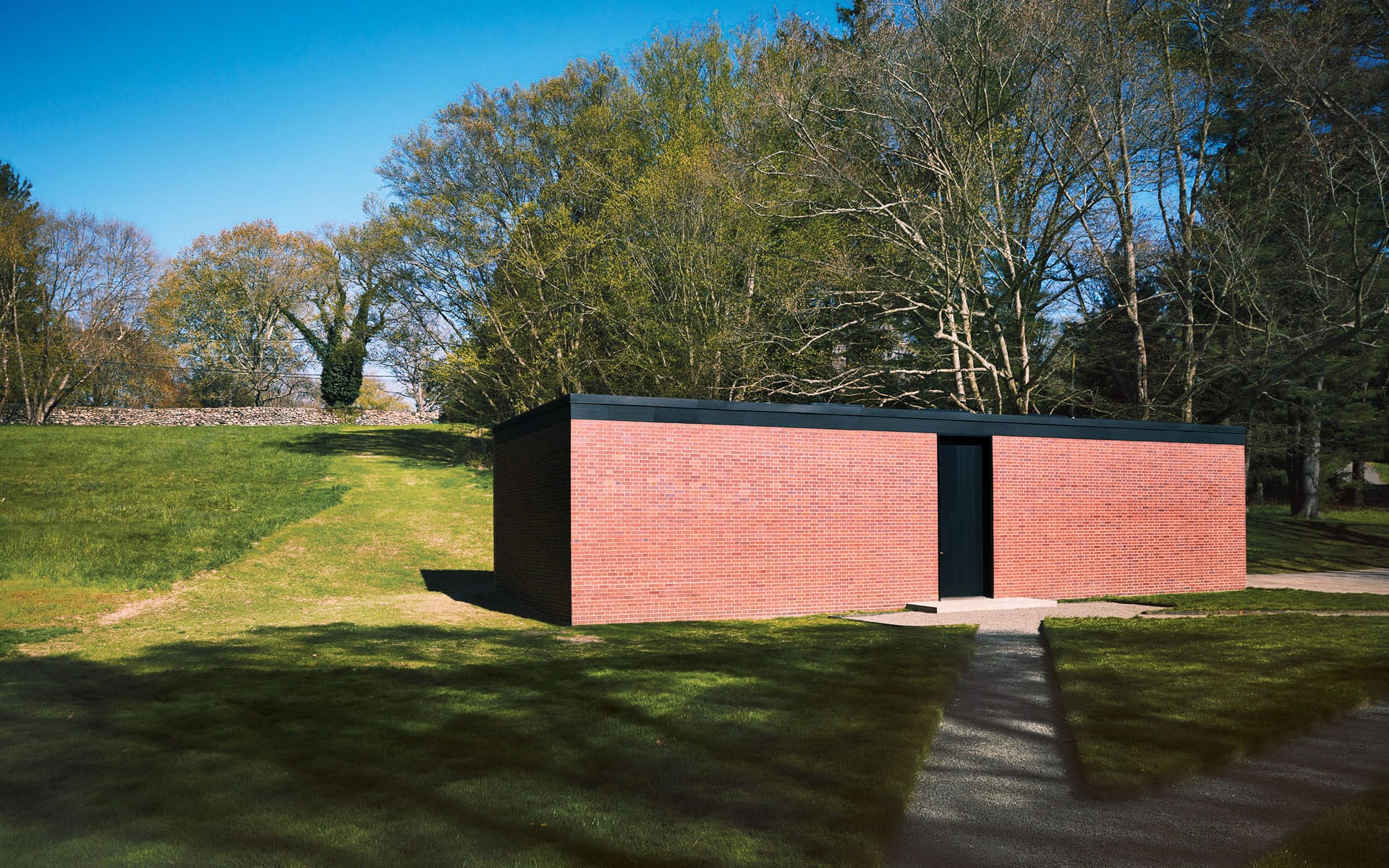This Glass House Landmark Once Visited by Andy Warhol Reopens After a Massive Restoration
Meticulously restored and reopened, the architect’s Brick House tells a story about the evolution of his architectural genius

In his later years, the architect Philip Johnson didn’t mince words on the subject of visitors spending the night at his Glass House retreat in New Canaan, Connecticut. As he put it in the 1997 documentary Philip Johnson: Diary of an Eccentric Architect, “my guests can damn well take the late train back to New York.”
But some did stay, notably Andy Warhol, who enlisted photographer David McCabe to document the occasion. Some of McCabe’s most famous shots captured Warhol in bed—not in the Glass House but in the nearby Brick House, where the artist is seen lounging under the covers beneath an elegant arched canopy, with a large abstract sculpture dominating the wall behind. Patterned fabric softens the other walls, while velour-upholstered poufs rest atop the room’s plush carpeting.

The cozy, cloistered space is not what anyone associates with Johnson’s Glass House, the radically transparent, minimalist box of glass and steel that stands as the ultimate domestic-scale distillation of the International Style championed by Johnson in his early career. But the Brick House, completed a few months before the Glass House in 1949, was an integral, if inevitably overshadowed, component of Johnson’s design.
In addition to housing the electrical and heating equipment for both buildings, the Brick House is an architectural foil, its masonry façade serving to deflect one’s gaze toward its glazed counterpart, according to Johnson. Punctuated by a plain black door on the front and a trio of circular windows on the back, the Brick House projects an attitude as modest as the Glass House is conspicuously self-assured.
Despite its modest mien, the Brick House tells an important story about Johnson’s evolution as an architect. And now, as the two buildings turn 75, that story is being more fully revealed, with the Brick House accessible to the public for the first time in nearly two decades following a comprehensive, $1.8 million refurbishment project.
Over the years, Johnson tinkered with the home’s interior. Totaling 860 square feet, it originally contained three identically sized rooms with porthole-style windows, plus a bath and a shallow entry hall linking everything. His most significant alteration came in 1953, when he combined two of the spaces into a larger bedroom while the third was kept as a library and sitting area.

“The Brick House was a domestic retreat for Johnson and David Whitney,” says Kirsten Reoch, executive director of the Glass House, referencing the architect’s longtime companion. “In a time when living as an out gay couple was still rare, this was a beautiful nest where they weren’t on view and could be themselves.”
The most distinctive feature Johnson devised for the bedroom is its vaulted white plaster canopy sprouting from slender columns, a neoclassical flourish indebted to John Soane that also softens illumination from the ceiling lights, which the architect put on a dimmer to facilitate shifting moods. Johnson preferred a simple, almost plinth-like bed without a headboard, nightstands, or even pillows. His other big gesture was commissioning Ibram Lassaw to create the openwork geometric sculpture in welded bronze and steel that hangs on the wall behind the bed, where it serves as a kind of abstract baldachin, as Johnson saw it.
The remaining walls are lined in a luxurious Fortuny cotton, the Persian-inspired Piumette design distinguished by gold feather forms and pale-blue scrolls handprinted on a dusty pink ground. For the renovations, Fortuny provided new fabric, which also clads sliding panels that can be used to cover the door and windows, enhancing the sense of enveloping softness.
“It’s supposed to be a room that invites you to romance,” Johnson says in the documentary, describing the decor as “a great breakthrough for me, to thumb my nose at my mentor, Mies van der Rohe, and to say things should be warmer and toastier and sexier than they are in modernist, square-beamed architecture.”
Architecture writer Paul Goldberger, chair of the Glass House’s advisory council, says that the Brick House interior marked “the first time Johnson began to seriously explore non-Miesian precedents. He was interested in something that was more sensual, and he was being more openly theatrical.”
While the bedroom prefigures Johnson’s eventual shift toward historicist design, the bath was redone in the mid-’80s, at the height of his postmodern phase. Expanses of richly veined white and black marble are crowned by decorative cornices featuring a classically inspired triglyphic pattern. Towel bars and fixtures are in burnished gold tones.
In the adjacent library, where one wall hosts a gridded floor-to-ceiling bookcase, Johnson introduced some idiosyncratic flair with a yellow window curtain, a pair of multicolor 1980s Gaetano Pesce Feltri chairs, and purple carpeting by Edward Fields (re-created by the company for the National Trust for Historic Preservation, which took over stewardship of the 49-acre estate after Johnson and Whitney died just several months apart in 2005). Johnson regularly repainted the walls in different shades, including the lively mint green from the ’80s, which was chosen by the restoration team. Paint guru Donald Kaufman, a frequent collaborator with Johnson, was brought in to help match the color precisely.

The art, meanwhile, is a selection of works from the couple’s collection that were not sold at auction after Whitney’s death. Black-and-white prints by Brice Marden that once graced the entry hall have been reinstalled there as well as in the library, where they are joined by works by David Salle and Vija Celmins along with a small Pablo Picasso sculpture.
Reoch imagines visitors will enjoy perusing the 950 books from Johnson’s personal collection, a fascinating window into his interests and thinking. The opening of the Brick House, Reoch notes, “gives a visual voice to how complex he was.”
A version of this article first appeared in print in our 2024 Fall Issue under the headline “Both Sides Now.” Subscribe to the magazine.
